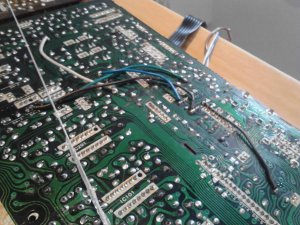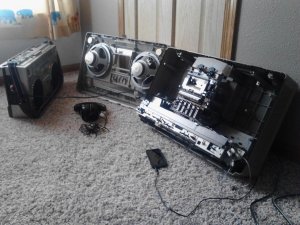You may say audio signal tracers are a thing of the past but really only because electronics have changed so much over the years that they aren't really applicable much in todays electronics. It certainly is not the only tool. You can inject a known waveform and trace with an oscilloscope too. But to be honest a signal tracer is far more useful and quicker in diagnosing issues with audio amplifers unless you are schooled in and know how to read (and even how to set up) an oscilloscope to produce a waveform, then you need to interpret the results. With the tracer, you can hear in an instant without having to take your eyes off the probe while with an oscilloscope, you'll need to view. Also, you can very easily hear the "quality" of the audio whereas with the scope, you can only "hear" with your eyes. Do you know what you are seeing or can you picture in your head what the picture in your eyes will sound like in your ears? Bottom line.... you are fixing a 35 year old device. Absolutely nothing wrong with using an instrument widely used 20-30 years ago.
As for the examples you showed... the handheld probe kit does sound interesting, but I don't see an attenuator. You will be testing everything from low line levels, to amplifier output levels. How will you attenuate the signal? As for using the home speaker to make your own.... I think you are far better off purchasing a commercial product designed for that purpose. You won't save that much making your own, and you also know nothing about the input impedance rating, don't have the probes or the jacks and such which will need to be purchased. By the time you are done, how much have you saved compared with using a product specially designed for signal tracing that was tested and has specs? It's important to know that high impedance is an absolute MUST. That is because when you probe a circuit, you need to know that your probe did not introduce a load onto the circuit causing it to not operate right. In other words, if you probe a circuit and you hear nothing, is it because the circuit shut down due to the additional loading introduced by the probe, or is it because the circuit is bad? Also, commercial products usually come with specially designed probes. I use a heathkit one that includes a high impedance vacuum tube amplifier with a built in vacuum tube cats eye that gives you a visual as well as selectable audio output. It has attenuators and the probe is switchable for RF or Audio signals. On one of the videos, the guy said you can hear a hum due to the flourescent lamps. Well, as you use that device, and you hear a hum, how will you intepret that? Is the hum part of the audio from your boombox, or is it from a nearby transformer or overhead lamps? I do not recall my heathkit ever picking up stray signals like that. In fact, the probe uses a shield cable with a signal ground. The home made ones uses regular unshieled probe wires that acts like antennas picking up anything and everything. You want to selectively test deliberate circuits, not accumulate random signals. Finally, none of those that I've seen (except maybe the probe kit... maybe) includes a coupling capacitor in the probe. This is important to block out DC. Otherwise, if you accidentally probe a 90v rail (certainly possible in a home stereo receiver), what happens to your home-made computer speaker tracer? Will it blow up?
In the end, you can experiment by building your own, but since specially designed instruments for that purpose don't cost much, and used vintage ones are very reasonably priced, I suggest you stick with a commercial instrument rather than a home built one with unknown specs and parameters. An unknown instrument testing an unkown working condition piece of gear results in unknown results.
I currently use this model:
[ebay]271389050893[/ebay] I'm not suggesting you buy this one, just telling you which model I personally use. There's another one right now on eBay at a current bid of $1.29 + shipping. There are more others even, some made by heathkit, some by Eico, etc. Before I spend one dime building my own custom computer speaker tracer, I would exhaust these options first. I might even buy/build that $35 pen probe one. I like the idea of an op amp based tracer because op amps have very low signal loading characteristics. However, that one requires ear buds. Hmmmm, if you accidentally probe a high level signal when you expected a low level signal and you have earbuds in your ear, does it blow out your ear drums? I know many times, I've probed a location to have the tracer emit a loud blast so with ear buds on........... Just wondering. Just saying.....
Oh and one last thing. Say you purchased one of those signal tracers for $30, or $35, or $99. When you are done and feel you don't need it anymore, I'll bet you can get close to what you paid for it. In other words, costed you close to nothing except the cost of shipping which you can chalk off as rent, provided you didn't get more. If you got a great deal or if you wish to take a hit, heck, I might buy it from you. But say you spend $10 or $20, or $35 to buy all the connectors, probes, jacks, switches, pots, etc etc to retrofit your own hack computer speaker signal tracer... what do you think the chances are someone will buy that from you? What do you think the chances of someone wanting to pay shipping for that thing, even offered for free?









